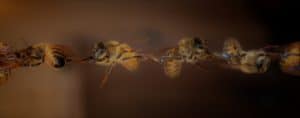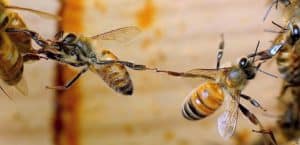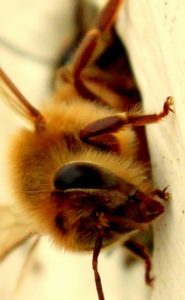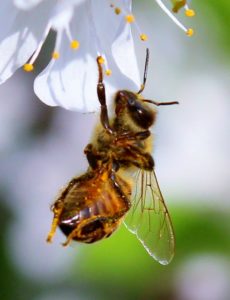Honey bees have had a close relationship with humans for thousands of years and have been intensively studied and observed by both scientists and beekeepers. Despite the accumulation of knowledge and ever increasing understanding of bee behavior, there are still a number of mysteries that bees guard. One of these behaviors that is yet to be thoroughly understood is called festooning. If you have ever been in a hive and noticed the bees seem clingy and hang from or between frames in chains, you have seen festooning.

It is not currently known why bees exhibit festooning behavior. There is general agreement, however, that the behavior is associated with wax production and is most commonly seen in the spring when comb is being drawn or repaired. One thought is that the bees cling to each other tightly to increase temperature and facilitate secretion of wax from glands on the underside of the abdomen. Another thought is that the bees are using their bodies as a sort of measuring device to assist in comb orientation and maintain the appropriate bee space critical to comb architecture. There is also a thought that festooning allows the bees to create a living scaffold or bridge in open space to aid the construction process. While the ‘why’ of festooning isn’t entirely clear, the ‘how’ can be observed by working slowly through a colony and gently separating frames resulting in lattices and chains of bees between adjacent combs. As these chains are stretched to several bees in length, it becomes evident that they are using their toes to hold onto each other and capable of quite a bit of contortion so long as they remain hooked to other bees.

The ‘toes’ that cling to each other are technically tarsal claws, the last segments of the end of each leg. Each of the six legs terminates in a pair of claws that together with the other structures of the lower leg provide a great deal of dexterity. In addition to hanging onto comb and other bees during festooning, tarsal claws allow bees to grip a variety of surfaces and textures which is particularly useful when foraging. Tarsal claws also allow bees to attach themselves to each other when hanging in a swarm or bearding in excessively hot or humid conditions. This previous post by my coworker Rob Snyder provides further explanation of the anatomy and functions of the lower legs and shows several examples of tarsal claws in a variety of bee species.


Having spent a dozen years working with bees, I have gained a decent understanding of many of their actions. Nevertheless, I’m glad that the bees still keep a few secrets to themselves. I always consider festooning a sign of spring and abundant resources in the environment that allow for colony growth and comb construction. In addition to being a general sign of good colony health, festooning is aesthetically pleasing. Every time I see it, I can’t help but think the bees are putting on a bit of a gymnastic display.